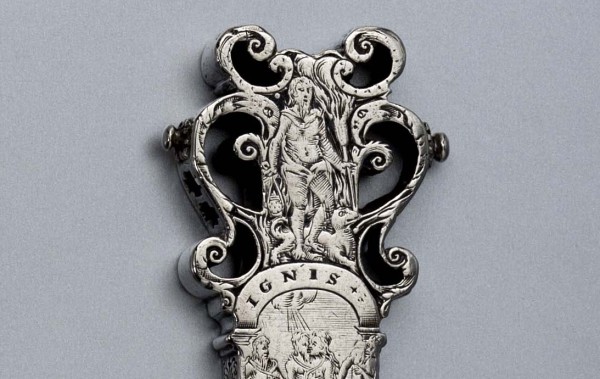
Here’s what I know about silver. It’s expensive, it’s hard to clean, and it’s more decorative than functional. My parents own more than I do, and my kids will probably own less than me. Which is why I asked Janine Skerry, Colonial Williamsburg’s curator of metals, to show me around Silver From Mine to Masterpiece, the new exhibit she and her team designed at the DeWitt Wallace Gallery.
I pretty much dared Janine to tell me why I should care about a bunch of pretty 18th-century ornaments. She rose to the challenge. The exhibit does feature some beautiful items, including King William III’s chandelier and a candelabrum made for King George III’s youngest son.
But I’d like to share some of my favorite things in the exhibit. They’re not all as pretty as some pieces, but to me they help to reveal how this precious metal is woven (smelted?) into our history.
A Big Ol’ Chunk of Silver
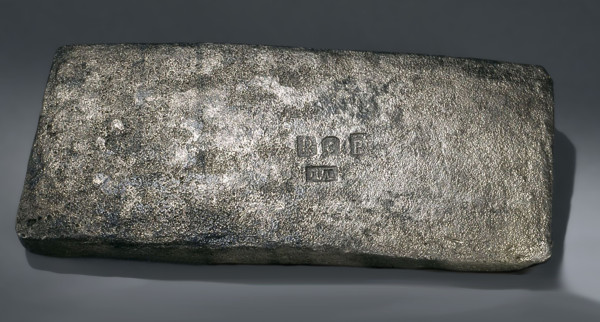
The Tumbaga ingot is just a silver-gray slab, a brick, perhaps seven inches long and three inches wide. But it’s one of the rarest things you’ll ever see. The Tumbaga ingot came from a shipwreck salvaged in the early 1990s, a Spanish galleon that sank off the coast of Grand Bahaman Island in the Caribbean. It was carrying about 200 of these silver slabs, the only ones known to exist today.
How could that be?
When Spanish conquistadors first arrived in the New World, they encountered Aztecs, Incas, and other civilizations that had been mining silver for centuries. In their cities the Spanish found silver and gold treasure beyond their wildest imagination. And they took as much as they could.
The treasures were bracelets, amulets, and ceremonial objects seized in the conquest. Mining came later. So the Spanish melted down the objects for easy transport back to Europe, where the precious metals would be separated and remade into new things.
So the silver only existed in this form while it was being transported. But seeing the Tumbaga ingot here reminds us that silver mostly originated in the Americas, and that many of these pieces have a history that often included courage and adventure, but also violence and conquest.
Paul Revere Pounded Here
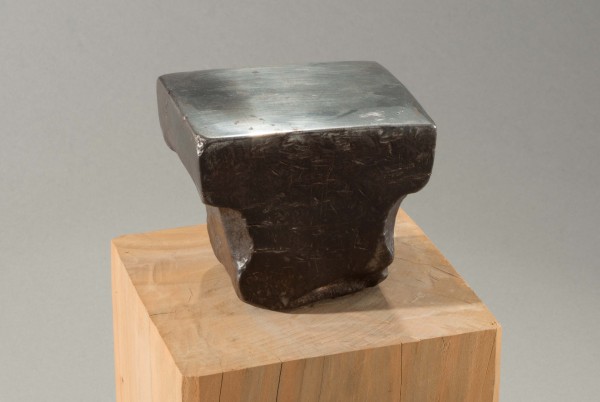
The first thing I think is that the anvil seems smaller than the one that was always landing on Wile E. Coyote’s head.
Janine says I’m right. This is a small anvil, also called a teest, and it can be traced all the way back to Paul Revere’s silver shop in Boston. Revere was a well-known silversmith before he got caught up in the whole Revolution thing, of course.
In the shop it would have been sunk into a wooden bench or even a tree stump. Here it is displayed with other implements of the trade: an 18th-century raising hammer, a tablespoon punch that would give the flatware its form, and a partially formed tablespoon from our own silversmith at The Golden Ball.
What I did not know is that in American shops, up to 90% of the business was repairing and cleaning silver. Some small pieces might be created on spec, but commissions for larger pieces were relatively rare.
Most of the economy worked on barter or bills of credit. Specie (hard currency, mainly coins) was hard to come by. But 250 years ago, even if you did have some hard currency, you wouldn’t usually put it in your bank account. But you might ask the local silversmith to fashion it into something both useful and valuable.
“That way I can use it, I can show off by using it, and if it’s stolen, I can say: stolen from my house last Tuesday night one tablespoon made by ye silversmith Paul Revere, marked by his initials, and with my cipher thereupon.”
Some Assembly Required
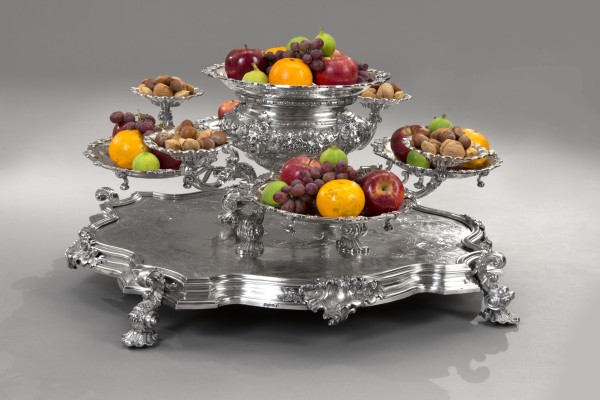
You can’t avoid all the beauty in the exhibit, of course, and for me, Joseph Leeson’s epergne kind of steals the show. Leeson used it in his home in County Wicklow, Ireland. It is an amazingly large and detailed piece that has a video showing how it assembles. How large, you ask?
It’s so large that it has a coding system of numbers that tells you what goes where.
It’s so large that its weight is partially supported by a concealed block of wood built into the underside of its plateau, or stand.
It’s so large that Janine tells me she bought several bags of fruit and nuts to show how it would have been used, and despite thinking she had bought extra, it took every last nut to fill it up.
“What I learned,” says Janine, “was that while this was a huge investment to order, it was also a huge investment to use. It couldn’t sit there empty. It had to be dressed out with fruit, nuts, and sweetmeats.”
The epergne has 21 pieces and stands 29” long, 24 ¼” deep, and 14½” tall.
The Duty Dodger
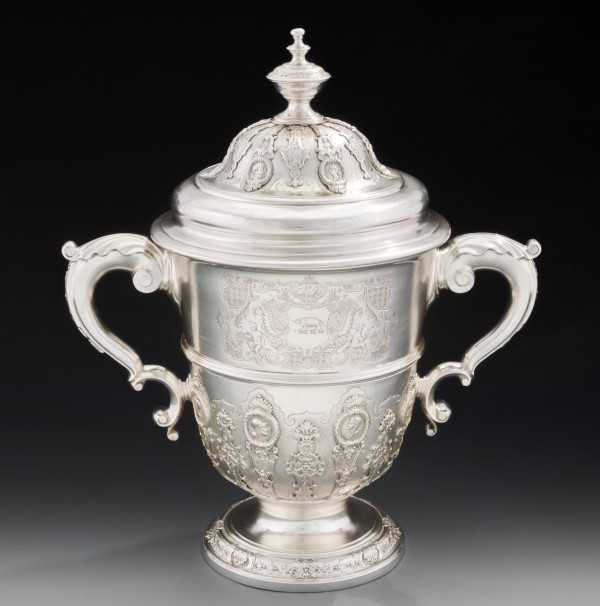
There’s an impressive two-handled covered cup under the description “Designed to Deceive.” Silverplate? Sherwin Williams Silver 226? No, even sneakier in its own way.
In the 1730s, when this cup was made, there was a tax on silver products based on their weight. This craftsman had a smaller piece properly sent for assay, but then soldered the marks into a much larger piece that would command a higher price, and give him a greater profit.
The reason English silver was “the best” was that its silver content was so regulated that the market had faith in its quality. Craftsman on the European continent also had access to silver, and many were superior craftsmen, but they didn’t have the sterling standard.
In England sterling was defined as an alloy of silver composed of at least 92.5 % silver to 7.5% copper.
Why is that important?
Janine explained, “You can make a silver alloy that might be 80% silver to 20% copper, and 99% of the people in this world will not be able to tell the difference by eye. If silver is more valuable than copper and you don’t know what you’re buying, I have a wonderful opportunity to cheat you.”
In 1327 (yes, almost 700 years ago) the Worshipful Company of Goldsmiths was chartered and given the responsibility for regulation and oversee production of metals to meet that standard
It still has a committee to identify fraud which is today “greatly facilitated by things like XRF non-destructive dispersive x-ray fluorescence,” according to Janine. In English, that means discerning the composition without harming the piece.
The Original Recyclable
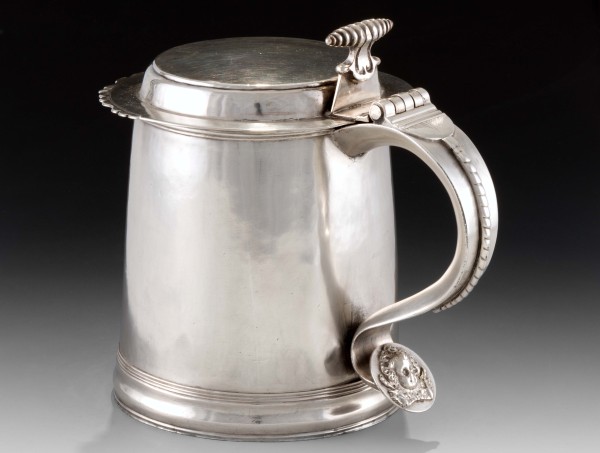
Two tankards from a Dutch family in New York share a funny history. In the 1820s, with the temperance movement sweeping the country, many vessels made for drinking adult beverages were melted down and turned into something more useful.
But the owner of these tankards instead added spouts on the side, turning them into covered pitchers. “Voila!” says Janine. “Perfect for serving newly popular ice water or other healthful beverages.”
Here’s where Janine delivers the payoff. Here’s what makes this exhibit different.
“At most traditional art museums a tankard that’s been spouted does not reflect the artist’s original intent, therefore it’s not of interest. It’s not exhibitable. At Colonial Williamsburg objects tell stories. And these objects tell fabulous stories about change over time to reflect real concerns in people’s lives.”
There’s a rich history to all this silver, and it’s not just because it’s pretty to look at. Gesturing toward my phone, Janine says, “You brought your silver with you today. Cellphones have to have silver in them. So do light switches, DVDs, all of our electronics. Silver is a little under the radar today, but it’s still a tremendous part of everyday life. We just don’t recognize it that way.”
You can take a virtual tour of the exhibit in the fabulous video below:

Wonderful article and video. I can’t wait to see the exhibit. I had the pleasure of working with Ms. Skerry several years ago and taking a tour of the earlier silver exhibit that she led. She’s a fabulous asset to CW.
I agree. In this post I was just hoping to convey a small portion of Janine’s enthusiasm.
Excellent article and accompanying video! Well done!
Ann Langerhans
Moorestown, NJ
Thank you. Hope you get to see the exhibit.